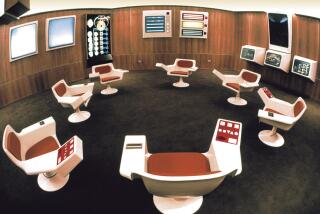THINGS TO COME : Armed Revolution
- Share via
Here’s the scenario: Some manmade formations are discovered on a highly radioactive portion of a nuclear test site in Nevada. The government has washed its hands of the whole affair. Now it’s the public’s turn. Using the Internet to control a camera and a robot arm at the site, they must come up with a hypothesis that explains the presence of a handful of artifacts found there--a pipe, goggles, torn pieces of newspaper, papers with cryptic equations and miniature model sea animals.
Actually, the formations and the artifacts are in a 5-foot-long sandbox located in a corner of a room at USC, part of what is essentially a highly sophisticated computer game. But the mind controlling the robot and studying the excavation could, via the Internet, be anywhere--across the hall or around the world. It is the only publicly accessible Internet site that allows users to interact visually and physically with a real--as opposed to virtual--environment.
“This is the first system to combine robotics, archeology and interactive art,” says Michael Mascha, a USC anthropology professor. Mascha, along with assistant professor of computer science Ken Goldberg and an interdisciplinary corps of graduate students, created and maintain the project.
Other sites on the World Wide Web--a portion of the Internet that allows sounds and images to be transmitted in close to real-time--link cameras at a site to remote computers, allowing users, through a graphical interface software called Mosaic, to actually see what the camera was seeing from anywhere on the ‘Net.
What we provide here is the logical next step,” Mascha says, while the system’s hydraulic pump fires a blast of air directed from a computer terminal in Chile. “We have an arm connected to the machine. So now you can not only observe the real world but also reach out and interact with it.”
Since going online last August, “The Mercury Project,” as its known, has been accessed by hundreds of users a day, each queing up for a five-minute foray in the sand. The address is https://www.usc.edu/dept/raiders/story/index.html.) They input what information they glean in a log that other excavators can read. Once someone solves the puzzle, the USC researchers have other projects ready to go.
Although the system is set up as a game, it’s geared toward letting an archeologist control the activity at a remote site. “The teacher could be in Europe, and the site could be in Australia and the students are in the U.S. and they could together make a dig. And the professor could say, ‘OK, now you students take over,’ ” Mascha says.
But the potential applications go way beyond that--to surgery, offshore oil exploration and virtual classrooms, to name a few. And thousands more applications ideas pour in through user feedback. “Whoever thought this one up is brilliant,” messaged one enthusiastic explorer from Rochester, N.Y. ‘Now if this could only operate the Shuttle’s arm.’
More to Read
Sign up for Essential California
The most important California stories and recommendations in your inbox every morning.
You may occasionally receive promotional content from the Los Angeles Times.












